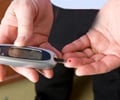- Trigger finger is a condition in which one or two fingers end up in a bent position and it is challenging to straighten them out
- Diabetic people have a higher likelihood of developing trigger finger
What is Trigger Finger
In trigger finger, one or more fingers, frequently the thumb or ring finger, end up in a bent position that is challenging to straighten out. It happens due to the thickness of the tendons and the connective tissue sheath that bend the finger. It is an uncomfortable ailment that is frequently managed with cortisone injections but occasionally necessitates surgery. “At the hand surgery clinic, we have noted for a long time that people with diabetes, both type 1 and type 2, are more often affected by trigger finger. Over 20% of those who require surgery for this condition are patients who have, or will develop, diabetes,” says Mattias Rydberg, a doctoral student at Lund University, resident physician at Skane University Hospital and first author of the study.The researchers looked at two registers: the Swedish national diabetes register and Region Skane's healthcare database, which contains all diagnoses, to determine whether elevated blood sugar levels increased the incidence of trigger finger. Trigger finger affects 1-1.5% of the population, although only 10-15% of those with diabetes are diagnosed with it, and those with type 1 diabetes are most likely to experience it.
Risk Factor for Trigger Finger
The recently released study supports the notion that blood sugar levels are a significant risk factor for trigger finger. For both men and women with type 1 diabetes and type 2 diabetes, high blood sugar has increased the likelihood of developing trigger finger. When it is under 48, the three months average blood sugar, also known as HbA1C, which measures blood sugar, is under control. Those with poorly controlled blood sugar (HbA1C > 64) were up to five times more likely to experience complications than men with well-controlled blood sugar (HbA1C < 48).“However, we can’t know for certain if any of the groups seek healthcare more often than others, which could be a factor that affects the results,” says Mattias Rydberg.
Causes of Trigger Finger in Diabetes
High blood sugar makes the flexor tendons and their connective tissue sheaths thicker, leading them to lock more easily, but the mechanism, if there is one, behind the elevated risk is unknown. It has long been understood that those with poorly controlled blood sugar levels are more vulnerable to nerve impingements in the hand.“It is important to draw attention to the complications from diabetes and how they can arise to discover them early, which enables faster treatment and thus a better outcome. In addition to nerve compressions and trigger finger, there may also be a link with the thickening of the connective tissue in the palm (Dupuytren’s contracture), impairment of joint movement and the risk of arthritis at the base of the thumb. The mechanisms behind these complications probably differ in the case of diabetes. The results of this study are interesting, as we can show that blood sugar dysregulation has a connection with the development of trigger finger,” says Lars B. Dahlin, professor at Lund University.
The research's next step will be to evaluate the effectiveness of operating on trigger finger patients who have diabetes.
“From our experience at the clinic, surgery goes well and there are few complications, but it takes a little longer for patients with type 1 and type 2 diabetes to regain full movement and function. We want to investigate this hypothesis further. Another interesting idea is to see if trigger finger could be a warning signal for type 2 diabetes. It is far from all who are affected by trigger finger that have diabetes, but it would be interesting to see if by using modern registers we can discover those who are in the risk zone for developing diabetes,” concludes Mattias Rydberg.
Source-Medindia















